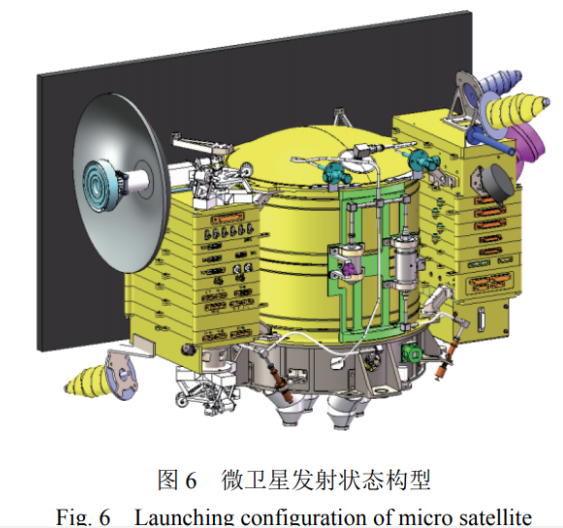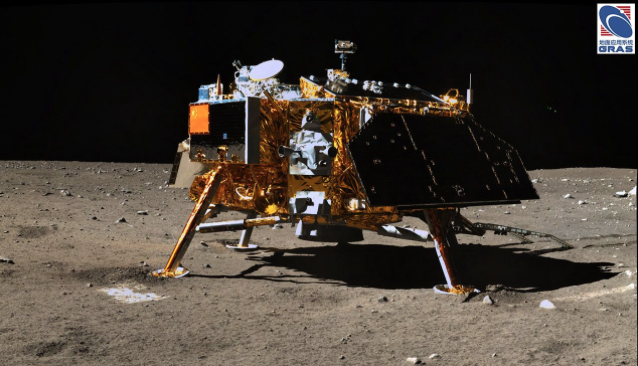China's Mission to the Far Side of the Moon will Include Test Microsatellites to Make History
China's two-launch Chang'e-4 mission to the far side of the Moon will include a pair of microsatellites to be placed in lunar orbit to test low frequency radio astronomy and space-based interferometry.
The pair, unofficially named DSLWP-A1 and DSLWP-A2, have a mass of about 45 kg each with dimensions of 50 x 50 x 40 cm and will launch along with a relay satellite in May or June this year.
Equipped with low frequency antennae and receivers, the astronomy objectives of DSLWP-A1 and A2 will be to observe the sky at the very low frequency part of the electromagnetic spectrum (1MHz-30MHz), corresponding to wavelengths of 300m-10m, with the aim of learning about energetic phenomena from celestial sources.
The primary aim of this first launch of the Chang'e-4 mission involves placing a relay satellite in a halo orbit at the second Earth-Moon Lagrange point beyond the Moon, from which it will facilitate communications with the Chang'e-4 lander and rover, which will be sent to the lunar far side in December.
The satellite is necessary as the far side of the Moon never faces the Earth due to 'tidal locking', and so transmitting data requires an Earth-Moon relay. This complexity is one reason the Chang'e-4 mission will be the first ever attempt at a soft-landing on the far side of the Moon.
The two microsatellites take advantage of extra space on the launch and will tag along for the journey to the Moon.
Low frequency radio astronomy
The pair of microsatellites will fly in formation at variable distances of 1-10 km in an unspecified, elliptical lunar orbit, testing space-based interferometry, which will allow for high angular resolution observations, by matching up radio waves collected by the pair from the same source at what is calculated to be the same time.

Launch configuration of the Chang'e-4 DSLWP microsatellites. JDSE
A decade after its first Moon mission, Chang'e-1, China is looking to expand its lunar plans with further robotic - and eventually human - exploration of Earth’s neighbour.
Due to the Earth's ionosphere, observations at these low frequencies is very hard, with almost nothing known about the sky in this frequency range.
This could bring unprecedented insights into the dark ages of the universe and transient astronomical events, such as supernovae and gamma ray bursts
The findings could therefore be tremendous, but the mission is only a test for potential future projects.
“As there are many limits on the preparation time, payload mass, power and communication bandwidth, the present mission is more an experiment, but what we learn from this could be very useful for the design of future missions,” says Chen Xuelei, of National Astronomical Observatory of China under the Chinese Academy of Sciences (CAS).
"Many astronomers around the world had proposed to observe at this low frequency range from space, and now we are proud that Chang'e-4 mission will give us the opportunity to make the first peek of the heaven in this frequency range," Chen says, adding that the team also look forward to collaborations with international colleagues on the low frequency radio astronomy.
DSLWP stands for 'Discovering the Sky at Longest Wavelengths Pathfinder', but the pair are likely to receive new names before launch.
A similar, larger scale mission, DSL, was proposed as a joint CAS-European Space Agency mission, but the SMILE mission was selected from the candidates.
Amateur astronomy, international payloads
DSLWP-A1 will carry an amateur radio payload developed by students at the Harbin Institute of Technology (HIT) in northeast China, allowing telecommand uplink and telemetry and digital image downlink. An open telecommand is also designed to allow amateurs to send commands to take and download an image.

The Chang'e-3 lander on Mare Imbrium, imaged by the Yutu rover. Chinese Academy of Sciences
DSLWP-A2 will carry a microcamera developed by the King Abdulaziz City for Science and Technology (KACST) of Saudi Arabia, one of the four international partners providing payloads for the Chang'e-4 mission.
Sweden, Germany and the Netherlands are all also involved in the mission, with a student outreach-inspired mini ecosystem, including potatoes, arabidopsis seeds and silkworm eggs, among the Chang'e-4 payloads.
The relay satellite is expected to be launched on a Long March 4C launch vehicle from the Xichang Satellite Launch Centre in Sichuan Province, southwest China in May or June.
The Chang'e-4 lander and rover, based on the Chang'e-3 mission spacecraft, will also launch from Xichang, aboard a Long March 3B, in December.
A soft-landing on the far side of the Moon has never been attempted, though a US Decadal Survey has highlighted the significance of such a mission.
The candidate landing sites for the lander and rover are within the South Pole–Aitken basin, a huge crater that may include lunar mantle excavated by the impact that formed it and thus offer unique insights into the interior of the Moon, what it is made of and how it formed.
Shaanxi Probecom Microwave Technology Co.,LTD (abbreviated as Probecom), was founded in 2002, located in International Trade and Logistic Park in Xi’an, we are mainly engaged in the design and manufacture of all types of satellite communication Earth Station Antenna, VSAT Antenna, Ka Series Antenna, Portable Flyaway Antenna, RxO/TVRO Antenna, SNG Antenna, On-the-Move Antenna, Remote Sensing & Telemetry Antenna, Meteorological Radars, High Power and Ultra Wideband Amplifiers (SSPA & TWTA), Microwave Components as well as the related Antenna Control & Tracking System.

